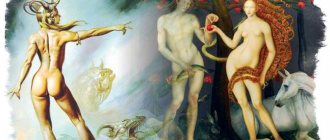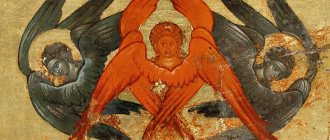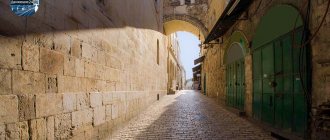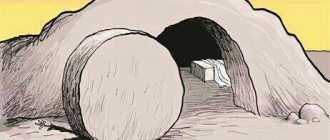There are quite a lot of words in the Russian language that denote a woman of easy virtue. Some of them are common, others are swear words. Also, some words came from the past and are now perceived by native speakers as an outdated lexical layer. An example of such a phenomenon is the “harlot.” Let's get acquainted with the shades of meaning of this word.
Who is the Whore of Babylon
The very word “harlot” appears quite often in Scripture, and in most cases in a figurative sense - this is how the Lord repeatedly calls his separated Jewish people, for numerous violations of the commandments given by Him.
The Babylonian harlot is mentioned for the first time in the Apocalypse of John the Theologian
This is the name given not only to a woman, but also to the people of God, who chose the alluring sinful nature over the pure love of God.
Origin of the expression
The expression is found in the last book of the Bible, the New Testament. Revelations is a letter written by the Apostle John on the island of Patmos during his exile. He sees several visions that show him the future.
In particular, in chapter 17, the apostle describes the appearance of an angel to him, who calls him to look at the great judgment that will soon take place (“The judgment of the great harlot who sits on many waters; with her the kings of the earth committed fornication, and those who dwell on the earth were drunk with the wine of her fornication.” Rev.17:1-2).
John goes on to call the woman who is being judged simply “Babylon the Great,” referring the reader to Old Testament times when the capital of Persia was a city of debauchery and vice. Below in the text, the woman is simply referred to as “harlot,” which subsequently led to the origin of the expression “Whore of Babylon,” despite the fact that such a phrase does not appear literally in Revelation.
Meaning of the word
“The Whore of Babylon” is an apocalyptic allegory in Christianity, the exact meaning of which many theologians and philosophers have tried to find out. This phrase is made up of two words: Babylon and harlot. It should be understood that the Apostle John did not use the exact expression; it appeared already during the interpretation of his book.
The Whore of Babylon is a female figure embodying sinful acts
A harlot in the Bible means a fallen woman who lives according to sinful principles and either cheats on her husband or does not have one at all and spends her nights in the company of different men. Today this is the name given to women whose depravity has reached unprecedented proportions, although the word is considered outdated.
During the time of the Kingdom of Israel, Babylon acted as a symbol of debauchery and sin. This city was the capital of Mesopotamia, it was inhabited by Persians, Sumerians, Amorites, Chaldeans, Arabs and other nationalities. During its heyday, it was a powerful city where all people flocked, especially the wicked and depraved.
The Old Testament describes the conquest of Israel by Babylon and the sinful desolation that followed. The Lord often rebukes Israel through the prophets, reproaching the Jews for flirting with sin and thirsting for immersion in a sinful life, just like the Babylonians. Therefore, Babylon is often used in metaphors and allegories as a set of depravity and vice.
Image from the Revelation of John
In Revelation 17, the Apostle John describes in detail what he saw at the trial to which an angel invited him. He explains to the apostle what he saw, interpreting the symbolism of what was shown. John sees a woman sitting astride a certain beast with 7 heads (Rev. 17:8).
She is dressed in expensive clothes, covered with jewels, and in her hand holds a cup that is filled with abominations. The angel says that this woman quenches her thirst with the blood of saints and martyrs, pointing to the seal of Babylon on her face. The Messenger of God also explains to the apostle the symbolic meaning of some details of this collective image:
- 7 heads - 7 mountains on which a woman and 7 kings sit. About the latter, the angel says that 5 of them have already fallen, only one remains, and the last one is coming, but for a short time;
- 10 horns are also 10 kings, but without kingdoms, who will share power with the Antichrist (the beast) for a short time;
- The waters under the woman’s feet are the entire population of the Earth, peoples and tribes.
It is still unknown whether the vision belonged to the period of the first centuries, when the change of kings occurred very quickly, and debauchery reigned everywhere, or whether it was about the future, i.e. time before the coming of Christ.
How does this relate to our times?
Photo: Flickr.com
If you do not look at what is happening from the point of view of politics or power, then the Whore of Babylon can become the progenitor of modern mass culture that has captured countries and continents, the so-called world government. It symbolizes false values, far from Christianity, the global popularity of stars, and very frank and depraved ones, a spiritual revolution in the minds and hearts of most people.
Under the beast, passions, anger, hatred and aggressiveness, animal motives or the devilish essence of its intentions can be mentioned, under the waters - the world, continents and countries. The red color of the robe speaks of world power, the distortion of values, and the cup is what ordinary people will replace Christian values with in their souls and hearts. Therefore, it is in the power of every believer to make a choice whether to open his heart to animal passion or to Christ.
( 3 ratings, average: 5.00 out of 5)
Historical prototypes
The Book of Revelation still causes ambiguous interpretations, since it is not entirely clear whether the apostle described the events of his time, i.e. already past or spoke about the future, i.e. time before the coming of Christ.
A harlot rides a beast with 7 heads and 10 horns
Regarding the vision, there are several versions of theologians and interpreters about real prototypes. The most common ones are the following:
- Priestesses at pagan temples - in those days, ritual prostitution was completely normal and women worked at each temple, who gave their bodies for payment to the men who came. This was especially common in Babylon, where the goddess of fertility Astarte was worshiped, as well as in Greek temples, where this tradition came.
- The Roman empress, the third wife of Claudius Messalina, became so famous for her lust and debauchery that ancient poets described her in their satirical works. According to contemporaries, she visited brothels at night, disguised as a prostitute, to satisfy her lust. Messalina died before the vision revealed to John, so he could be describing her.
It is impossible to say with certainty which version is accurate, since the book of Revelation is a metaphorical work and the true prototypes were known only to the author.
Image or reality
Photo: Flickr.com
There are several versions of whether such a woman was real or not. Temple prostitution existed in Bethlehem when Malaysian women waited for men in the pagan temple of Aphrodite. Foreigners were the priority. The man had sex with the woman outside the temples, then threw coins into her lap. After that she could go home. In the future, she no longer had the right to be sold for money. But, most likely, this was not the case. After all, if a woman once fell into sin, it is unlikely that she will continue to do the same.
According to another version, the image could have been taken from Empress Messalina. This woman was famous for her amorous exploits. Many famous people mentioned her debauchery. However, her depraved actions did not reach the scale that was described in the event.
Interpretation
During the entire existence of the last book of the Apostle John, many interpretations were put forward, including theologians who tried to decipher the meaning of this image. Many said that the face of the Roman Empire was hidden under it, some argued that it was about Israel, and some were even inclined to believe that it was a collective inspiration for the coming depravity into which the world would plunge. However, the 18th chapter of Revelation speaks for the first two versions, where the author talks about the fall of Babylon.
One of the most controversial, but interesting interpretations is the version of the Protestant church reformers, including Martin Luther, who argued that we are talking about the Catholic Church, which plunged into depravity. And the Pope was considered the incarnation of the Antichrist.
In theology
Interpreters and theologians tend to view the woman riding the beast as the personification of the sin raging in the world. She is a companion of the Apocalypse, and remembering the words of Christ that in recent times sin will increase, we can assume that the dissolute virgin is a symbol of madness and evil that will happen in the world.
The female figure of a sinner riding a beast symbolizes the sin of fornication
Many theologians also believe that this character was attributed to the Roman Empire, which was filled with debauchery and fornication. And the kings that John mentions changed quite a lot before her fall.
In modern world
This expression has now lost its relevance; even the word “harlot” is almost never used in simple speech and is replaced by modern definitions. This phrase is found today in a figurative meaning in a situation where we are talking about a common character, distinguished by debauchery and depravity.
The image of the harlot in culture and art
The figure is richly reflected in works of art. Many examples of secular painting and iconography show us an apocalyptic multi-headed beast and his rider. And in our time, this tandem appears on the pages of fiction and the silver screen.
Painting
When depicting the harlot, artists usually followed the description from the text of Revelation - this is a richly dressed woman with a cup in her hand, seated on a seven-headed beast. The plot is reflected mainly in the art of small forms - book illustrations, engravings and miniatures. Thus, in the art of the West, it is worth highlighting the largest series of 64 tapestries from the Middle Ages, stored in the French castle of Angers.
The plot also found application in Russian Orthodox art, including Old Believer art. In addition to book illustrations, examples of fresco painting have been preserved. Here you can note the painting on an apocalyptic theme in the Holy Trinity Monastery of St. Daniel of the 17th century, which is located in Pereslavl-Zalessky.
From the art of the Renaissance, an engraving by the German artist Albrecht Durer is known. The author showed the harlot of the Apocalypse in the form of a contemporary courtesan from Venice - the image was made from life. At the same time, for contrast, the beast is shown here as ugly and disgusting as possible.
The figure of the beast's rider is also found in icon painting. In the Assumption Cathedral of the Moscow Kremlin there is a corresponding work from the 15th century. However, here the image is devoid of repulsive features and to a certain extent follows the ancient canons of art with its plot of the abduction of Europe by a bull.
Literature
In works of art, the figure of a harlot is found more often in the form of an epithet, an ironic expression, or a direct reference to the text of Scripture. Its mention can be found in the sonnets of John Milton, classical Russian literature, including the work of Pushkin, as well as the fiction of the Pole Andrzej Sapkowski. Angel de Coitiers dedicated one of the books of his mystical cycle to the harlot.
Cinema
The figure has also found many representations in films, and here the imagination of authors and directors knows no bounds, and the first experiments on this biblical theme began already at the dawn of cinema.
Metropolis (1927) directed by Fritz Lang. In this silent film, you can see the dance of the end of the world, with a robot playing the role of the great sinner.
"Omen-2" (1978), a famous thriller on the theme of the coming of the Antichrist. A statue of a harlot is shown in an abandoned church.
“The Ninth Gate” (1999), a mystical film based on the novel by Arturo Perez-Reverte, where there is an engraving of her image.
“Supernatural” (2005-present), a series where in the episode “99 Problems” the wife of the Apocalypse impersonates a prophet, taking on the guise of a pastor’s daughter.
“Dexter” (2006–2013), a detective series, where in the episode “Sin of Omission” the murder of an elite prostitute is investigated, and one of the scenes is named after the harlot from Revelation.
Music
Apocalyptic stories have always attracted rock musicians.
The figure of the harlot was used by the following artists in their lyrics, titles and album designs:
- Avenged Sevenfold;
- Iced Earth;
- Bright Eyes;
- Ordo Rosarius Equilibrio;
- The Killers;
- Behemoth;
- Gaza Strip.
In religion
The Bible is the sacred book of many schools and denominations, and the Book of Revelation is interpreted differently depending on the teachings of the Church and the times. Thus, the Whore of Babylon was interpreted by different representatives in a completely different way:
- Protestants - during the Reformation, Martin Luther and his followers called the Roman Church a libertine, and the Pope - the Antichrist.
- Old Believers - when a schism occurred in the Russian Orthodox Church in Russia, the schismatics called Patriarch Nikon, and with him the entire Church, a libertine. They considered Moscow to be Babylon, and occasionally they also called Rome, the center of the Catholic Church, that way.
- Jehovah's Witnesses - denying the truth of all other movements, they firmly consider them Babylonian whores.
In the past, the term was widely used in the ideological struggle between different churches
The inaccuracy of Revelation and its complete metaphorical nature has led to the fact that it is interpreted as a whole and this expression in completely different ways. At the same time, using John’s vision at his own discretion as evidence of his own views.
Like an image of a city
In theology, there are two main theories about who is hidden under the type of the woman on the beast. The first and main version claims that in this way John refers to the Roman Empire, which in those years was at the peak of strength and power, which, as in all times, was accompanied by debauchery and fornication, and was also located on 7 hills (“sits on 7 mountains ).
At the same time, the words of the angel “was drunk with the blood of the saints” can be attributed to the persecution that Christians of the first centuries experienced from the emperors of Rome.
Interesting! On Roman coins from 70 AD. (Revelation written around 80 AD) the empire was depicted as a woman sitting on 7 mountains. Babylon in this text is the encrypted name of Rome, and the harlot is a collective image of all the sins and abominations that occurred in the capital.
An alternative version of theologians says that Babylon in this text is Jerusalem. This theory is also supported by the statement about 7 mountains - Jerusalem stands on exactly this number of hills. In addition, during the time of John the city was filled with depraved affairs, Christ was killed here, and religious fanatics actively persecuted Christians. The city was destroyed in 70 AD, which also fits the description of the 18th chapter of Revelation - the fall of Babylon.










